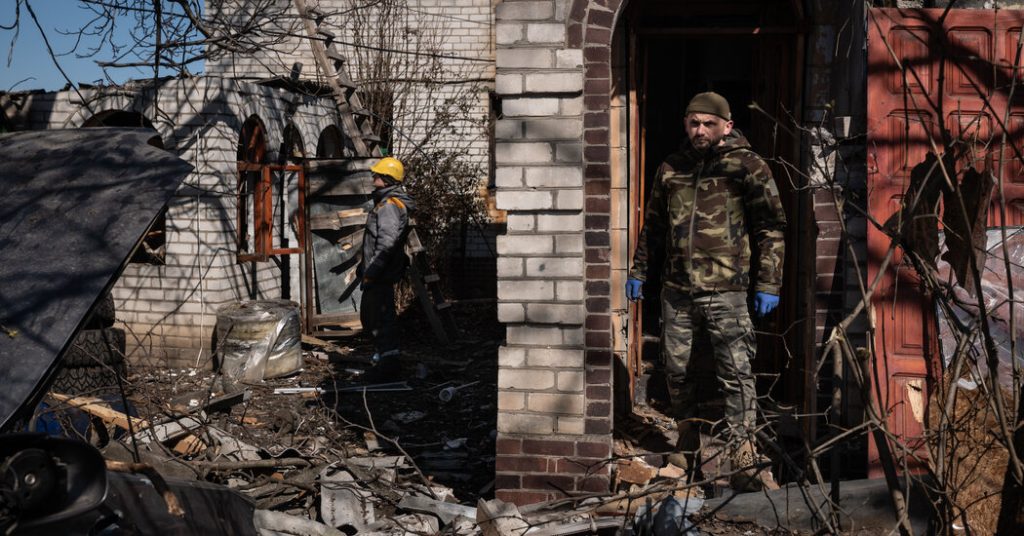Ongoing Tensions Before Cease-Fire Talks
As Ukraine and Russia gear up for discussions aiming at a temporary suspension of attacks on energy infrastructure, both nations continue to blame each other for new assaults on the power grid, highlighting the profound mistrust that exists between them.
Early Friday, a significant Russian energy facility near the Ukrainian border, which previously supplied natural gas to Western Europe, was ignited in an assault that both sides claimed was initiated by the other. Videos posted by Russian military bloggers and corroborated by The New York Times displayed a large blaze at the gas metering station, suggesting that nearby pipelines were also engulfed in flames.
On the same day, Russian officials in the Krasnodar region reported a secondary explosion at a fuel depot that had been ablaze for two days following a Ukrainian drone attack. They stated that the fire had extended over more than 100,000 square feet.
Cease-Fire Agreement with Unresolved Details
This week, Kyiv and Moscow came to an agreement for a 30-day cease-fire concerning strikes on energy infrastructure, marking the first significant step toward de-escalation after over three years of conflict. This agreement followed separate discussions between President Trump and the leaders of Russia and Ukraine to facilitate the partial cease-fire.
However, the specifics regarding how and when this partial truce will be implemented remain unclear and are set to be finalized during U.S.-mediated talks in Saudi Arabia on Monday. President Volodymyr Zelensky of Ukraine stated that his government would compile a list of infrastructure sites eligible for the cease-fire to prevent misunderstandings.
Impact of Strikes on Energy Infrastructure
Strikes on energy facilities have been pivotal in both countries’ attempts to undermine one another throughout the conflict. Russia has targeted Ukraine’s power grid with the goal of making life intolerable for civilians and hampering the nation’s military capabilities. Conversely, Ukraine has focused its attacks on Russia’s vast oil industry to disrupt revenue streams that support military operations.
On Wednesday, Ukraine’s national railway service reported that its power system had been targeted. That same day, Russia claimed that Ukrainian drones attacked a fuel depot in the Krasnodar region. Neither of these claims could be independently validated.
Claims and Counterclaims Amid escalating Propaganda
Both sides are keen to assign blame for any potential violations of the cease-fire even before it takes effect, aiming to depict their adversary as untrustworthy. In this context, Friday’s assault on the Russian gas facility fit neatly into this ongoing propaganda struggle.
On Friday, Mr. Trump refrained from commenting on whether he would enforce sanctions against Russia for its attacks on Ukraine and avoided recognizing that Russia had invaded Ukraine.
Russian and Ukrainian Reactions to the Attack
The fire at the gas facility occurred just across the border from Ukraine, near Sudzha, in territory that Ukrainian forces had captured during a previous incursion into Russia’s western Kursk region last summer. Recent Russian advances have, however, pushed Ukrainian troops back in the area, leaving unclear whether they still controlled the gas site as of Friday.
The Russian Defense Ministry accused Ukraine of “deliberately” destroying the Sudzha gas metering station during its military withdrawal from the region, labeling the attack a “deliberate provocation” aimed at undermining the U.S. president’s peace efforts. In contrast, the Ukrainian Army suggested that the blast was a false flag operation by Russia meant to place blame on Ukraine.
Implications of the Attack on Gas Exports
Historically, the station was the only transit point for Russian gas to the European Union via Ukraine. Operations halted on January 1 after Ukraine declined to renew the transit agreement, part of a broader objective to decrease dependency on Russian energy. This means that the recent attack will not have an immediate effect on Russian gas exports; however, severe damage could present long-term challenges and affect the potential for resuming exports post-war.
Damien Ernst, an energy expert at the University of Liège in Belgium, noted that damage visible in the aftermath of the attack suggested “significant” harm that might take months to repair. In a separate strike on Thursday, Ukraine targeted arms depots at a military airfield deep within Russian territory, with verified satellite images revealing multiple craters at the site and what appeared to be destroyed munitions storage facilities.



